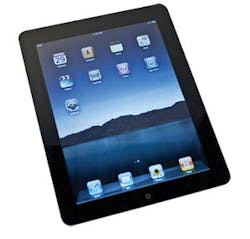The Apple iPad: A tablet computer designed for Internet browsing, media consumption, gaming, and light content creation.
• The recently released iPad tablet reader has some aviation professionals already looking at how the new device can benefit the industry. A recent post by Max Trescott on his Aviation Trends Aloft online blog (www.maxtrescott.com) outlines iPad pros and cons and some of the latest aviation applications avialable to iPad users; following are some highlights:
— The iPad ships in two versions, each of which is available with 16, 32, or 64 GB memory. The version shipping now has built-in WiFi for Internet connectivity. However, it does not have a built-in GPS. This may make moving map apps unusable, so pilots will probably want to get the 3G version that includes a GPS and ships in late April. The 3G models will require a data plan from a cellular carrier and cost $130 more than the WiFi versions.
— One of the biggest benefits for aviators is the iPad’s long ten-hour battery life. That makes it practical to use the iPad most of the day, regardless of whether you’re in the cockpit or a passenger traveling in coach. The iPad’s 9.7-inch display is bright and responds quickly when touched. The iPad is also light, just 1.5 pounds, though some users commented that it feels heavy if left on your leg for an hour or more. It’s also relatively inexpensive for a computer, just $499 for the basic 16 GB WiFi model.
— About a half dozen aviation applications have been optimized for the iPad and others are in the process. Converted iPad apps include MyRadar Pro, a weather application, two chart applications, and Foreflight, a multipurpose product that includes weather briefings, airport directory information, flight plan filing, and a moving map.
IATA’s E-Services
• According to the association, paper miscellaneous documents issued by airlines require legacy paper processes and infrastructure to be maintained. The International Air Transport Association’s (IATA) e-services project will replace these paper miscellaneous documents with electronic versions, according to a global IATA electronic miscellaneous document (EMD) standard.
EMDs are designed to work like electronic tickets (ETs) and are stored electronically in the issuing airline’s database. Usage can be tracked just like flight coupons in an electronic ticket. The EMD can be used to collect charges for all types of services, including amendment fees, excess baggage charges, and to issue refunds.
Benefits for airlines:
• Annual industry-wide savings of between U.S. $2.4 and $2.9 billion from lower costs and increased revenue, according to IATA.
• Lower costs due to simplified revenue accounting and back office processing.
• Increased revenue by selling more services through more channels.
Benefits for passengers:
• More flexibility, allowing passengers to customize their journey purchasing only the services they value, from fast track security to WiFi access.
• Easier access.
• Less hassle and stress.
The Targets: Capability in all Global Distribution Systems and ten airlines by 2011, and 100 percent industry capability by the end of 2012.
About the Author

